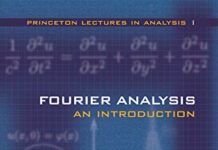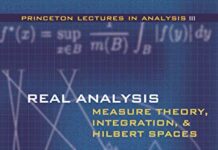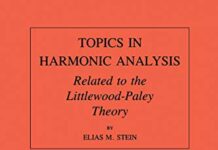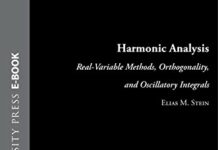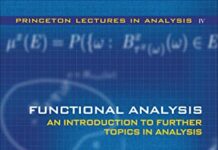
Ebook Info
- Published: 2003
- Number of pages: 400 pages
- Format: PDF
- File Size: 2.93 MB
- Authors: Elias M. Stein
Description
With this second volume, we enter the intriguing world of complex analysis. From the first theorems on, the elegance and sweep of the results is evident. The starting point is the simple idea of extending a function initially given for real values of the argument to one that is defined when the argument is complex. From there, one proceeds to the main properties of holomorphic functions, whose proofs are generally short and quite illuminating: the Cauchy theorems, residues, analytic continuation, the argument principle. With this background, the reader is ready to learn a wealth of additional material connecting the subject with other areas of mathematics: the Fourier transform treated by contour integration, the zeta function and the prime number theorem, and an introduction to elliptic functions culminating in their application to combinatorics and number theory. Thoroughly developing a subject with many ramifications, while striking a careful balance between conceptual insights and the technical underpinnings of rigorous analysis, Complex Analysis will be welcomed by students of mathematics, physics, engineering and other sciences. The Princeton Lectures in Analysis represents a sustained effort to introduce the core areas of mathematical analysis while also illustrating the organic unity between them. Numerous examples and applications throughout its four planned volumes, of which Complex Analysis is the second, highlight the far-reaching consequences of certain ideas in analysis to other fields of mathematics and a variety of sciences. Stein and Shakarchi move from an introduction addressing Fourier series and integrals to in-depth considerations of complex analysis; measure and integration theory, and Hilbert spaces; and, finally, further topics such as functional analysis, distributions and elements of probability theory.
User’s Reviews
Editorial Reviews: Review “Elias M. Stein, Winner of the 2005 Stefan Bergman Prize, American Mathematical Society” About the Author Elias M. Stein is Professor of Mathematics at Princeton University. Rami Shakarchi received his Ph.D. in Mathematics from Princeton University in 2002.
Reviews from Amazon users which were colected at the time this book was published on the website:
⭐The authors are great writers, who present the topic in a valuable historical context. Nevertheless, this book moves fast — all the beautiful results that distinguish the “nice” behavior of complex-differentiable functions from the “ugly” ones of differentiable functions of real variables are proved in the first three chapters. It then quickly goes on to discuss more advanced results relating to Fourier analysis (most notably, the Paley-Wiener theorem) and techniques (e.g., the Phragmen-Lindelof principle), followed by some interesting applications of complex analysis to number theory.For a first undergraduate course in complex analysis for math majors (i.e., a theory course, as opposed to a course primarily concerned with computing contour integrals), coverage of the first four chapters plus a few selected topics (e.g., the Riemann mapping theorem, properties of the Gamma and Zeta functions, etc.) with the harder exercises and easier problems assigned should already make for a fast paced course, despite what the preface of the text claims. A course in real analysis based on Rudin’s Principles of Mathematical Analysis should probably be considered a prerequisite. The proofs are written in a way for someone already quite comfortable with rigorous arguments, with the reader expected to be able to supply the routine epsilon-delta manipulations that are left out when the authors feel like they are tedious.As a warning, many of the exercises are rather difficult, while the problems are quite involved and even the easier ones will take even good students many hours (or even days) of thought while the harder ones may be out of reach unless substantial hints are given by the instructor. No problem or exercise is really a “routine” verification or computation.That said, the mathematics is beautiful, and I had the good fortune of taking this course from Prof. Yum-Tong Siu, an expert in the field and an inspiring instructor. This was also my mathematical swansong, since I was taking the course in my senior year, and I was headed to grad school in organic chemistry. The work load was a bit high because of this new text, but the course was rewarding.
⭐Just received the 2nd of 4 textbooks by E.M. Stein & R. Shakarchi about math analysis. No wonder Princeton U. cranks out so many prominent mathematicians.
⭐The actual content has been ably reviewed already. I will address only the particulars of this printing. This printing is a photocopy of the original, as you can see from the human hair on one of the first pages. The Chinese translation of the preface is titled “Photocopy Preface” according to Google Translate. According to Princeton University Press, this title was licensed for printing in 2006 for distribution solely in China, and they are aware that copies have been distributed outside of China. If none of this bothers you, then… enjoy!
⭐This book has an extremely indirect style which excites instructors but tortures students. Similarly to books like Hatcher’s algebraic topology, it assumes background on the level of 1-2 books on the topic. The book has interesting non-standard material and ideas, particularly about zeta functions, but as a student, one could read and complete all problems in Rudin in a similar time to reading this book and gather a much solider foundation of the subject material.Read Rudin, then chapters 6, 7, and 9 of this book look to be great bedtime reading. Learning from the early chapters of this book is utterly pointless. Classical texts are much better written on the basics.
⭐As others have said, the book is very nice to read, the exposition is clear, motivated, and meaningful. It does take quite a bit of work to get through the book, however, the efforts will be rewarded very well with a good solid understanding of complex analysis.Much of the books content is actually contained in the exercises in the back of each chapter, so it is very important to work through the exercises. Many important concepts are developed by the reader, guided by the book, in the exercises. Sometimes preliminaries to matters developed in later chapters are seen in the exercises.If you plan to self study complex analysis then this book will be a very good challenge. This book would also be a good companion book to any complex analysis class(or a very good primary text).
⭐I didn’t care much for my complex analysis class as it seemed to computational with not as much care in the theory as I’d like. Luckily for me, this book filled in all the gaps and more in just the first few chapters. The section on branch cuts and the log function should appear slightly earlier and for that I’d suggest skimming that section after reading chapter 1 (log function in chapter 4). Other than that great book for beginning complex analysis.
⭐The two authors are indeed very good writers. This book presents the elements of complex analysis at the graduate level (so the assumption is that the reader has gone through undergraduate real and complex analysis). All the topics covered are covered well (I especially like their treatment of the Prime Number Theorem and Elliptic Functions). Note: theorems of Picard and Mittag-Leffler are not proved in the textbook – they are actually assigned as exercises for the reader to prove). If you need the proofs of these theorems, look them up elsewhere. Overall, a very solid book.
⭐If possible, I would give this book 4.5 starts, just because I don’t think it is quite as good as the great classic by Conway, “Functions of One Complex Variable” (which treats all the standard topics). On the other hand, Stein and Shakarchi’s book is beautiful, lucid, and obviously written by one of the grandmaster analysts of our time. Also, I give it five stars for including a beautiful treatment of the Paley-Wiener theorem, a topic that doesn’t usually make its way into elementary complex analysis texts. Finally, this book has the best treatment I’ve seen of the Hadamard factorization theorem.
⭐It is true that it came fast and the price was fair but it was stated as “like new” and the “dust jacket” was missing. I believe that this was needed to be stated in the description. Indeed the book itself was like new.
⭐Ottimo prodotto che mantiene quello che promette . Le spiegazioni interne, sono molto utili per conoscere le potenzialità del prodotto .Tempi di arrivo e confezionamento eccellenti.IMPECABLE
⭐Good one
Keywords
Free Download Complex Analysis (Princeton Lectures in Analysis, No. 2) in PDF format
Complex Analysis (Princeton Lectures in Analysis, No. 2) PDF Free Download
Download Complex Analysis (Princeton Lectures in Analysis, No. 2) 2003 PDF Free
Complex Analysis (Princeton Lectures in Analysis, No. 2) 2003 PDF Free Download
Download Complex Analysis (Princeton Lectures in Analysis, No. 2) PDF
Free Download Ebook Complex Analysis (Princeton Lectures in Analysis, No. 2)
